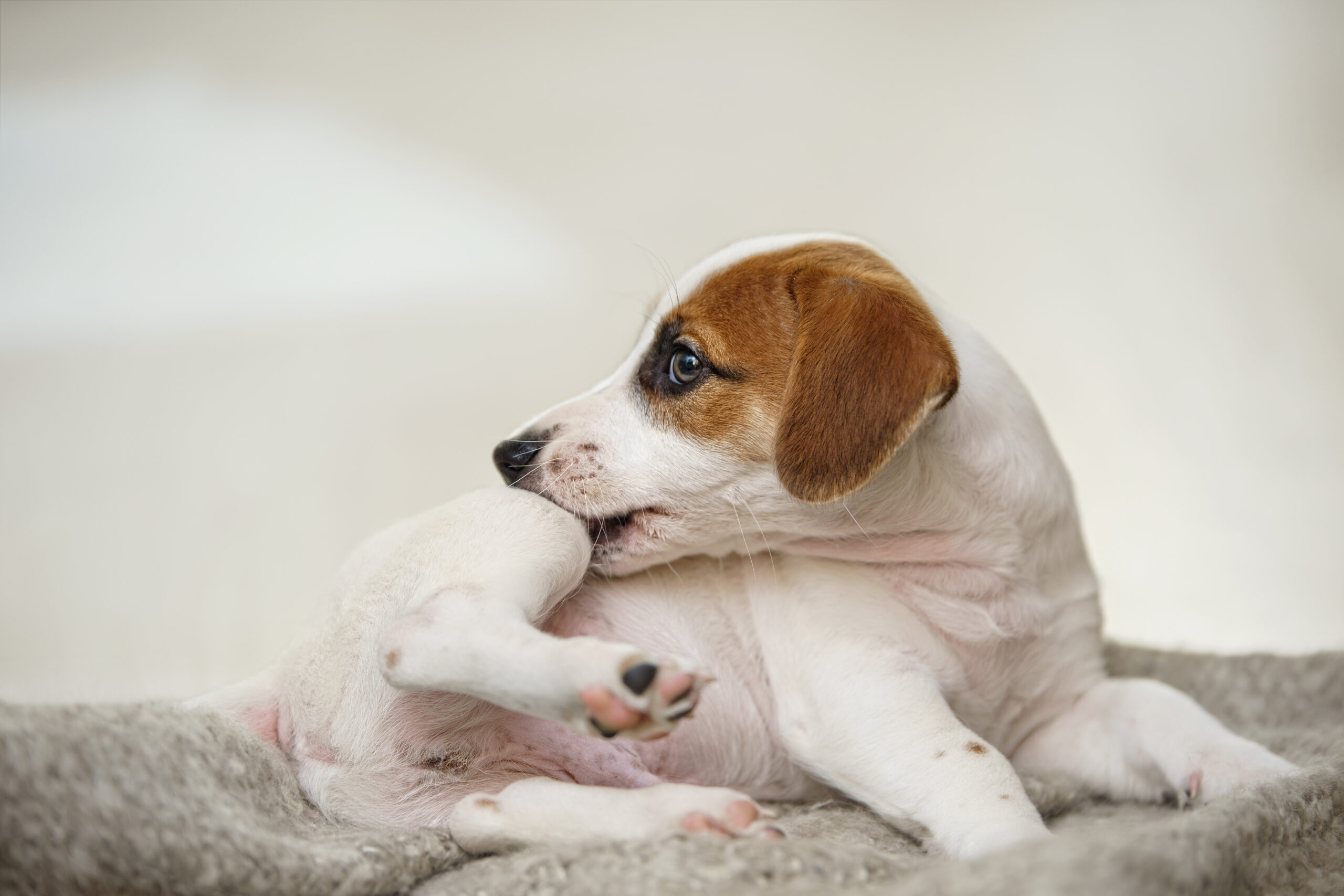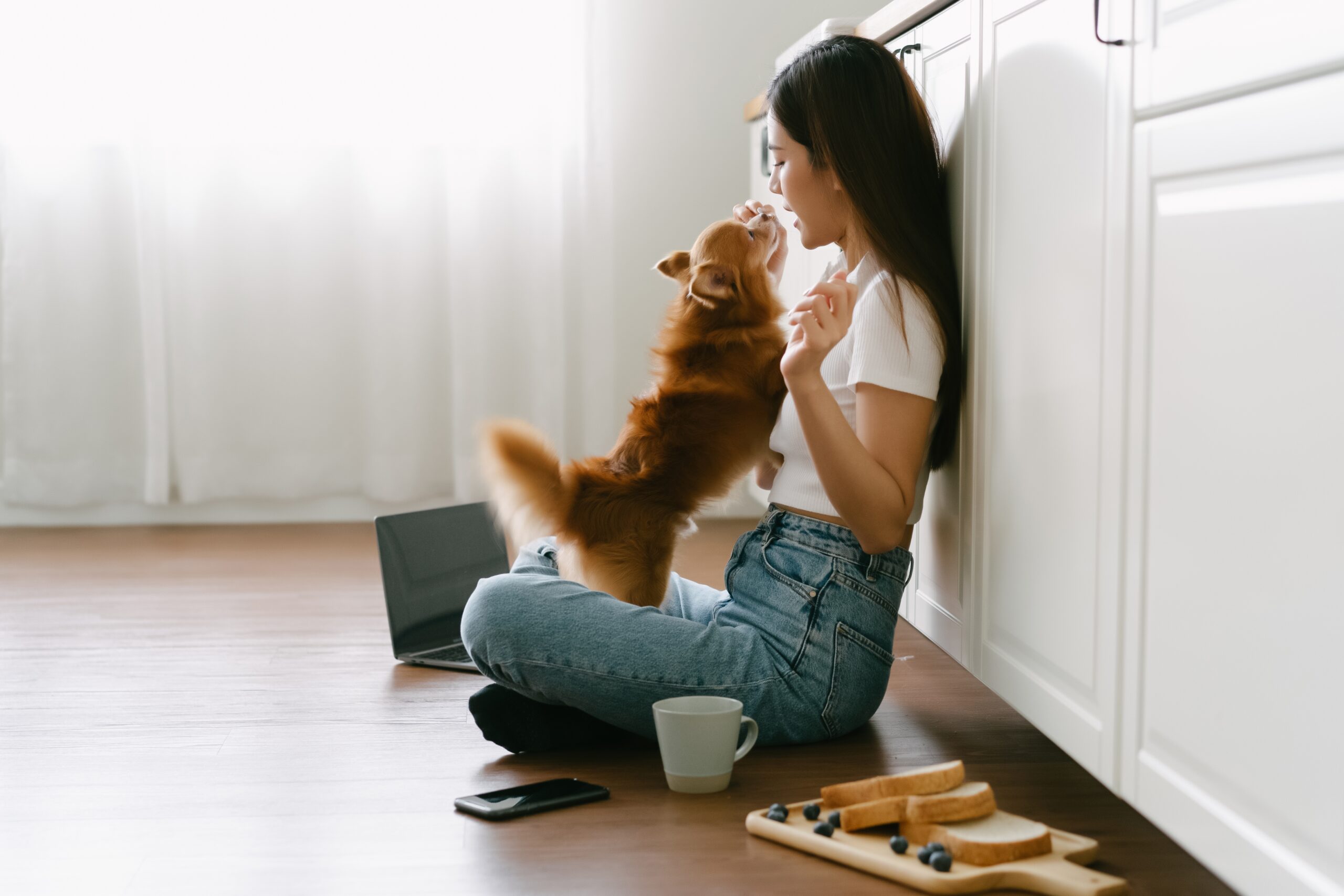Nikki is a petite marketing copywriter by day, unicorn-chaser by…
About a month ago, my boyfriend noticed a small lump under his dog Winter’s armpit. Since then, it’s been an emotional rollercoaster for all of us. While the situation has been stressful, we’re incredibly grateful that he caught it early, because it allowed us to start treatment right away.
Obviously, no one wants their dog to be sick, obviously, but doing simple routine checks like this can make all the difference in catching issues early. To help you keep an eye on your furry best friend’s health, here are some easy dog health checks you can do right at home.
The Nose-to-Tail Examination
Here’s your step-by-step routine for an at-home dog check-up:
1. Eyes
- What to check: Eyes should be bright, clear, and moist. The whites (sclera) should be white, not yellow or bloodshot. Look for symmetry in both eyes and similarly sized pupils.
- Warning signs: Discharge, cloudiness, redness, swelling, or reluctance to open the eyes.
- Why it matters: Cloudy or red eyes could signal infection, allergies, or more serious issues.
2. Nose
- What to check: The nose should be moist, cool, smooth, and free from cracks or crusts.
- Warning signs: Dryness, sores, unusual discharge, color changes.
- Why it matters: Persistent dryness or discharge can signal dehydration, fever, or infection.

3. Ears
- What to check: The outer flap and visible ear canal should be clean, light pink (unless your dog has black-pigmented skin), and odor-free. A tiny bit of wax is normal, but there should be no redness, swelling, or debris.
- Warning signs: Strong odors, excessive wax, redness, visible sores, or frequent scratching at the ears.
- Why it matters: Smelly, dirty ears often suggest infection or mites and merit prompt attention.
4. Mouth, Teeth, Gums
- What to check: Gums should be pink and moist (some breeds have natural pigment spots). Teeth should be white and clean, with no loose or broken teeth. Breath should be neutral, not foul.
- Warning signs: Bad breath, tartar buildup, redness or swelling of gums, broken teeth, ulcers, or bumps.
- Why it matters: Dental disease can impact overall health. Bad breath may signal infections or systemic health problems.
5. Skin & Coat
- What to check: The coat should be shiny, clean, and free from bald patches. The skin beneath should be supple, smooth, and free from dandruff, scabs, or rashes.
- Warning signs: Hair loss, flaky skin, redness, swelling, bumps, scabs, or signs of fleas/ticks.
- Why it matters: Skin and coat health reflect internal wellness. Persistent scratching or licking can indicate allergies or skin disease.
6. Body Condition
- What to check: Gently run your hands along your dog’s ribs. You should be able to feel each rib without pressing hard but not see the ribs plainly. View your dog from above and from the side: there should be a visible waist and a tuck at the belly.
- Warning signs: Rapid weight gain/loss, very thin or overweight appearance, sagging belly.
- Why it matters: Weight changes can signal health problems or dietary issues.

7. Paws and Nails
- What to check: Each paw pad should be smooth and intact, without cuts or cracks. Nails should not be overgrown, curling, or split.
- Warning signs: Swelling between toes, redness, bad odor, or torn pads/nails.
- Why it matters: Sore paws or overgrown nails can make walking painful for your dog.
8. Legs & Joints
- What to check: As you run your hands over your dog’s limbs, feel for lumps, heat, swelling, or areas of tenderness. Observe your dog’s gait and watch for limping or stiffness when they get up or walk.
- Warning signs: Limping, reluctance to exercise, swollen joints, pain on touching legs.
- Why it matters: Early joint or muscle issues are easier to manage if caught quickly.
9. Abdomen
- What to check: Gently press your dog’s belly. It should feel soft—not swollen, hard, or painful.
- Warning signs: Signs of pain, sudden bloating, lumps, or redness.
- Why it matters: Abdominal problems can be serious and may need urgent veterinary attention.
10. Genitals & Anus
- What to check: Check for redness, swelling, lumps, or abnormal discharge. Area should be clean, not soiled.
- Warning signs: Persistent licking, swelling, pain, blood, or pus.
- Why it matters: Infections, parasites, or cancers sometimes show up here. Note behaviors like scooting that might signal anal gland or worm issues.
11. Tail & Spine
- What to check: The tail should move freely with no pain or sores at the base. Run your hand down the spine from neck to tail, checking for pain or unexpected lumps.
- Warning signs: Stiffness, pain, limping, abnormal posture, swelling.
- Why it matters: Spinal issues can cause serious discomfort or mobility loss.

Behavioral and Daily Habits
Daily observations are just as important as physical exams. Keep an eye out for changes in:
- Appetite: Dramatic changes in how much or how eagerly your dog eats can be a warning sign.
- Drinking/urination: Increased or decreased thirst or urination could indicate health issues.
- Bowel Movements: Stools should be firm, brown, and easy to pick up. Diarrhea, constipation, or blood warrant a vet check.
- Energy/mood: Is your dog happy, alert, playful, and responsive? A dog who is dull, lethargic, or in visible discomfort might be ill.
When to Contact the Vet
Schedule a vet visit if you notice:
- Persistent vomiting or diarrhea.
- Severe or sudden lameness.
- Loss of appetite or weight.
- Bleeding, swelling, or discharges.
- Pale, blue, or very red gums.
- Signs of pain or distress lasting more than 24 hours.
Once at the vet, don’t forget to mention all your dog’s health information and any findings you have to help them make an accurate diagnosis.
How to Keep Your Dog Healthy
Being able to tell if your dog is healthy is a valuable skill, but preventing health issues before they happen is even better. Here are some easy and effective tips to help keep your dog happy and in great shape:
- Feed a balanced diet suitable for your dog’s age, size, and activity level.
- Ensure daily exercise to maintain muscle tone, weight, and mental stimulation. Exercising your dog during the rainy season can be a bit trickier, but it’s definitely do-able! If heading outside isn’t an option, playing indoors can still get their blood flowing and keep them happy.
- Brush teeth regularly and provide dental chews or toys.
- Keep up with flea, tick, and heartworm prevention.
- Groom and bathe as needed based on breed and coat type.
- Keep vaccinations current and have regular wellness checks with your vet.
- Provide plenty of fresh water at all times.
- Show lots of love and attention!

Partnering for Your Dog’s Health
You know your dog better than anyone else and are often the first to notice when something feels off. Regular at-home health checks like these empower you to catch potential problems early and take prompt action. However, they are not a replacement for professional care. It’s important to keep up with regular veterinary wellness exams, ideally every six months, to ensure your dog stays as healthy as possible.
By combining your attentive, hands-on care with your vet’s expertise, you’re giving your furry best friend the best chance at a long, happy, and thriving life. With this partnership, you can face any health challenges together, confident that you’re doing everything possible to keep your dog safe, comfortable, and loved.
What's Your Reaction?
Nikki is a petite marketing copywriter by day, unicorn-chaser by night with a thirst for exploring the big world.

